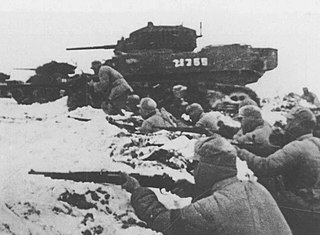Zhengtai Campaign was a series of battles fought between the nationalists and the communists during the Chinese Civil War in the post World War II era, and resulted in the communist victory.
The Winter Offensive of 1947 in Northeast China was a series of battles initiated by the Communist forces against the Kuomintang (Nationalists) during the Chinese Civil War after World War II.
The Summer Offensive of 1947 in Northeast China (东北1947年夏季攻势) is a series of battles initiated by the communists against the nationalists during the Chinese Civil War after World War II.
The Autumn Offensive of 1947 in Northeast China was a series of battles initiated by the communists against the nationalists during the Chinese Civil War after World War II.
Linfen Campaign (临汾战役) was a series of battles fought between the communists and the nationalists during the Chinese Civil War to control the city of Linfen, and resulted in the communist victory.
The Campaign of the North China Plain Pocket, also called the Breakout on the Central Plains by the Chinese Communist Party, was a series of battles fought between the nationalists and the communists during the Chinese Civil War, resulting in a successful communist breakout from the nationalist encirclement. The campaign marked the beginning of the full-scale civil war fought between the communists and the nationalists in the post-World War II era.
The Campaign in the Eastern Foothills of the Funiu Mountains (伏牛山东麓战役) was a series of battles fought between the nationalists and the communists during the Chinese Civil War after World War II for the control of western Hubei and the border areas of Hubei, Honan and Shensi provinces. The campaign resulted in the communist victory.
The Campaign to the South of Baoding consisted of several battles fought in regions south of Baoding between the nationalists and the communists during the Chinese Civil War after World War II, and resulted in the communist victory.
The Yanzhou campaign, also known as the campaign at the central section of the Tianjin-Pukou Railway, was a series of battles fought between the nationalists and the communists for the control of the town Yanzhou (兖州), which is today under the administration of Jining, and the region to the north of the town in Shandong, China during the Chinese Civil War in the post World War II era, and resulted in communist victory.
The Hebei – Rehe – Chahar Campaign (冀热察战役) was a series of battles fought in Northern China between the nationalists and the communists during the Chinese Civil War in the post World War II era, and resulted in communist victory.
The Zhoucun–Zhangdian Campaign (周张战役), short for the Campaign of Zhou's Village and Zhang's Hotel, consisted of two major battles and a series of smaller battles that followed, fought between the Communists and the Nationalists in Shandong during the Chinese Civil War in the post–World War II era. The outcome was a Communist victory. This campaign is also called the Campaign at the Western Section of the Qingdao–Jinan Railway (胶济路西段战役).
Campaign along the Southern Section of the Datong-Puzhou Railway (同蒲路南段战役) was a campaign fought between the nationalists and the communists during the Chinese Civil War in the post-World War II era and resulted in the communist victory.
Datong-Jining Campaign (大同集宁战役) was a series of battles fought between the nationalists and the communists mainly in northern Shanxi and the surrounding regions during the Chinese Civil War in the post-World War II era. The main battlefield was centered on two cities, Datong and Jining.
The Campaign to the North of Daqing River was a series of battles fought between the nationalists and the communists in Hebei, China during the Chinese Civil War in the post-World War II era.

The Taiyuan campaign was a campaign of the Chinese Civil War fought between the nationalist and communist factions. The campaign was over the control of Taiyuan, the capital of the province of Shanxi, China. The campaign resulted in a communist victory.
The Battle of Jiulianshan was an unsuccessful counter-guerrilla operation launched by the nationalists against the communists during the Chinese Civil War in the post-World War II era in the border region of Guangdong, Jiangxi and Hunan.
Gongzhutun Campaign was a series of battles fought in the regions of Gongzhutun in Northeast China between the nationalists and the communists during the Chinese Civil War in the post-World War II era and resulted in communist victory. The campaign was part of the Winter Offensive of 1947 in Northeast China.

The Battle of Shuangduiji (双堆集战役) was a major campaign fought between the nationalists and the communists during the Chinese Civil War in the post-World War II era, resulting in a communist victory. The campaign was part of the Huaihai campaign.
Campaign to Suppress Bandits in Liuwandashan was a counter-guerrilla / counterinsurgency campaign the communists fought against the nationalist guerrilla that was mostly consisted of bandits and nationalist regular troops left behind after the nationalist regime withdrew from mainland China. The campaign was fought during the Chinese Civil War in the post-World War II era in the region of Liuwandashan in Guangxi and resulted in communist victory. This campaign is part of Campaign to Suppress Bandits in Guangxi, which in turn, was part of Campaign to Suppress Bandits in Central and Southern China.
Battle of Shangcai was a series of clashes fought between the nationalists and the communists during Chinese Civil War in the post World War II era, and resulted in the communist victory. The battle is also called the Blockade at Shangcai by the communists, who launched the battle to support their Eastern Hennan Campaign, with intention to prevent the nationalist force from reinforcing their comrades fighting the Eastern Hennan Campaign.



